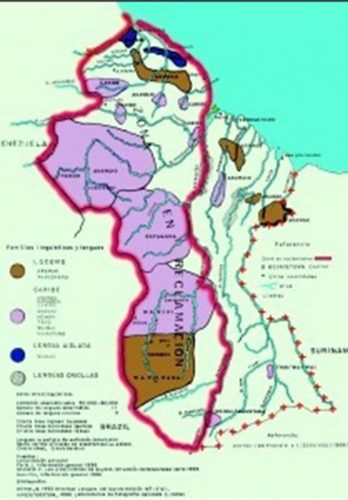Dear Editor,
The South Rupununi District Council (SRDC) letter of 2nd December 2023 states that they stand firmly with “our fellow Guyanese”. This is welcome given memories of the 1969 Rupununi Uprising. The SRDC’s letter may also help to counter the Communique, “Nine Declarations to those who will not listen”, which was issued in January 2013 by a group calling itself the Amerindian Peoples Liberation Front and claiming to speak on behalf of all Amerindians in Guyana. The Communique included a map showing Essequibo in red as the “Zona en Reclamation”. A Wapichan area was marked in brown in the supposed “Zona”.
However, the SRDC’s letter contains some legal and historical inaccuracies.The SRDC claim to be the “legally representative institution” of 21 communities in the South Rupununi. They are not. Under the Amerindian Act s13, only Village Councils can represent Amerindian communities. A District Council is limited to advice, assistance, coordination and other activities to support the Village Councils as set out in s35. It is atrocious that 15 years after the Amerindian Act was passed, successive Governments have failed to educate Amerindians on their legal rights, including the many options for protecting themselves against exploitation by others.
Archaeological evidence (e.g. ‘Archaeological investigations in British Guina’ by Evans and Meggars) has long established that the Wapichan inhabited the Brazilian savanna and did not enter Guyana until the end of the eighteenth century. De Villiers as well as Evans and Meggars refer to a map of 1748 which shows the Macusi north of the Takatu River and the Wapichan south of the Takatu River in Brazil, not Guyana. The petroglyphs suddenly claimed by the SRDC were for centuries disclaimed by the Wapichan. They belong to earlier people – probably the Atorad and Taruma who, according to the Amerindian Lands Commission Report, were displaced by the Wapichan. The SRDC’s revisionist approach is wishful thinking in the face of historical data.
The Amerindian Act 2006 guarantees the right of all Amerindians to describe themselves by any term that is of cultural or social significance. The SRDC call the Wapichan “indigenous peoples”. But saying you are ‘indigenous peoples’ does not confer any legal rights to land. Indigenous land rights are based on pre-colonial occupation of land not on post-colonial migration. The Wapichan people in Brazil are legally prohibited from owning land like the rest of Brazil’s indigenous peoples. In contrast, the Wapichan who migrated to Guyana now own land under absolute and collective land titles granted by the State. As should be well-known by now, land claims are settled under the Amerindian Act 2006 based on traditional occupation, use of land, culture, spiritual association with the land etc.
Finally, SRDC’s letter was written in the context of Venezuela’s spurious claim to Essequibo. Under international law, the Dutch acquired sovereignty over Guyana by ‘occupation’ i.e. settling a land that did not have any indigenous legal system. Any Amerindian peoples claiming indigenous land rights would have to show that an indigenous legal system existed prior to colonisation. But then the Dutch would not have been legally able to acquire sovereignty over Guyana by occupation, the British could not have gotten sovereignty from the Dutch and we could not have gotten it from the British.
Amerindian claims for indigenous land title (also called native or aboriginal title) are incompatible with Guyana’s sovereignty over Essequibo and should be dropped. But if Amerindians persist in claiming indigenous land title, such claims should be dismissed unless there is any judge in Guyana who is willing to undermine Guyana’s sovereignty.
Sincerely,
Melinda Janki






